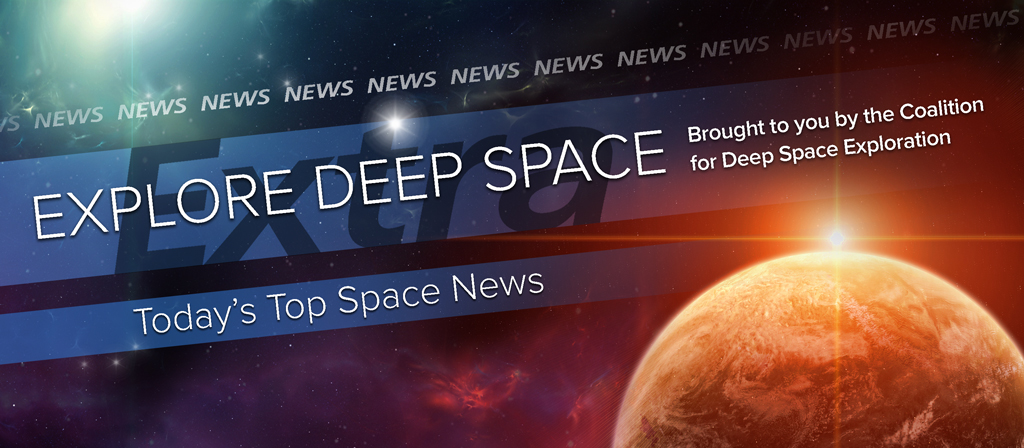In Today’s Deep Space Extra… Pending legislation would establish a human Mars landing as NASA’s top priority.
Human Deep Space Exploration
Draft bill proposes wide-ranging space policy changes
Space News (3/1): The American Space Reconnaissance Act, sponsored by Oklahoma Congressman Jim Bridenstine, seeks changes in policy across NASA, the Department of Defense and other civil federal agencies. Among its provisions, the legislation seeks to establish a “pioneering doctrine” within NASA and establish a human landing on Mars as the agency’s “main priority.” It would cancel the Asteroid Redirect Mission, unless the agency can establish a compelling reason to continue its pursuit. The bill encourages the U.S. government to obtain more weather data and other services from commercial providers.
NASA scores successful Orion solar array deployment test
Spaceflight Insider (3/1): Tests at the NASA Glenn Research Center’s Plumbrook Station on Feb. 29 confirmed the mechanism for deploying the Orion crew capsule’s 24 foot long solar array panels built by European Orion service module contractor Airbus Defence and Space. More testing this fall will verify the deployments, following the simulated stresses of a rocket launch. The work is in preparation for Exploration Mission-1, an unpiloted joint test of the Space Launch System exploration rocket and Orion planned for late 2018.
NASA project in Hawaii simulates 1-year Mars mission
National Public Radio (3/1): In Hawaii, the rocky slopes of the Mauna Loa volcano play the part of the Martian terrain in a yearlong simulation of a human exploration mission. In the current simulation, six people have just crossed the mid-point. The dome like habitat is solar powered, the food is freeze dried.
Relics of the apace age
New York Times (3/1): Photographer Roland Miller’s new book Abandoned in Place features aging hardware and structures from Cape Canaveral, F.L.. to White Sands, N.M. and Edwards Air Force Base, Calif., that cradled the V-2 rocket and Saturn V rocket engines and other creations that helped to start America on its way to space.
Space Science
Could laser weapons save Earth from killer asteroids?
Spaceflight Insider (3/2): DE-STAR and DE-STARLITE are two laser technology strategies proposed to offer defenses against asteroids and comets that pose a collision threat to the Earth. While the technology is emerging, the development of such defenses on a large scale could be a challenge. The first weapon would reside in Earth orbit. The smaller DE-STARLITE would travel to its target.
‘Train like a Martian’ Challenge inspires kids to get active
Space.com (3/1): Brainchild of the nonprofit The Mars Generation, the “Train like a Martian” initiative strives to encourage children and adults alike to become and stay physically fit. April events will coincide with International Space Station astronaut Tim Peake’s plans to run the London Marathon while he orbits.
Low Earth Orbit
Scott Kelly, American astronaut, returns to Earth after 340 days in space
New York Times (3/2): U.S. astronaut Scott Kelly and Russian cosmonaut Mikhail Kornienko settled to the remote plains of Kazakhstan late Tuesday, ending a 340 day trip to the International Space Station. Their long journey, a NASA record for consecutive days in space, is to reveal the challenges of the long missions needed to reach deep space destinations with human explorers. Cosmonaut Sergey Volkov commanded their Soyuz spacecraft to its landing.
Kelly, Kornienko land after “year in space” mission aboard ISS
Spacepolicyonline.com (3/1): New U.S. spaceflight record holder Scott Kelly will make his way back to his Houston home and training base, the Johnson Space Center, by late Wednesday. Kelly’s long trip to the International Space Station concluded with a landing aboard a Russian Soyuz capsule in Kazakhstan on Tuesday at 11:26 p.m., EST. He shared the long journey with Russian cosmonaut Mikhail Kornienko.
What one year of space travel does to the human body
The Atlantic (3/1): Spaceflight challenges the body’s sense of balance, weakens bones and muscle, blurs the eyesight and poses a threat from exposure to higher levels of radiation.
Extreme spaceflight: The history of yearlong space missions
Space.com (3/1): At 340 days, the lengthy spaceflight to the International Space Station by NASA’s Scott Kelly and cosmonaut Mikhail Kornienko ranks fifth on the list of long duration space missions. Russian Valery Polyakov reached 438 days aboard Russia’s former Mir space station in 1994-95.
Commercial to Low Earth Orbit
Op-ed | The space renaissance: The government as an early adopter
Space News (3/1): A global renaissance is underway in aerospace innovation, writes Planet Lab’s Robbie Schingler and Richard Leshner. They suggest it will change the U.S. government’s contractor role to that of interested consumer, when it comes to NASA and NOAA.

